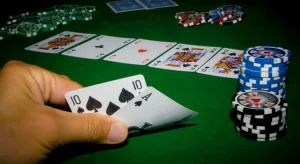7 Card Stud Hi Lo
Seven Card Stud Hi-Lo is an exciting blend of two classic poker games: Stud and Razz. This variant combines the traditional elements of Stud with the reverse hand ranking of Razz, creating a dynamic and challenging game that will appeal to a wide range of poker enthusiasts. For those unfamiliar with this hybrid poker style, diving into the world of seven-card Stud Hi-Lo may seem daunting at first glance. However, the unique structure of the game, in which both the highest and lowest hands are encouraged, opens up paths to victory.
If you haven’t yet learned how to play this exciting variation of poker, you’ve come to the right place. This guide is designed to explain the rules, strategies, and nuances of Seven Card Stud High-Low in a way that is accessible and understandable to beginners. Whether you’re new to poker or looking to expand your knowledge beyond the more familiar games like Texas Hold’em or Classic Stud, we’ll provide you with the basic information you need to get up to speed quickly and start working your way to victory.
How to Play 7 Card Stud Hi Lo
Seven-card stud high-low, often called stud 8 or seven-card stud eight or better, is an interesting type of poker that combines elements of stud poker with low hand wins in razz. The essence of the game is to compete for two halves of the pot by forming the highest and lowest qualifying five-card poker hand. Unlike traditional poker games where the highest hand reigns supreme, in Seven Card Stud Hi-Lo players can strategize for two different outcomes, which greatly enriches the tactical depth and appeal of the game.

In Seven Card Stud Hi-Lo, play proceeds through a series of betting rounds called “streets,” beginning with the dealing of two down cards and one up card to each player (third street), followed by three additional up cards (fourth, fifth, and sixth streets), and ending with the last down card (seventh street or river). Each street opens up new hand formation opportunities and requires a betting round in which players can adjust their strategies based on the strength of their hands and the actions of their opponents.
A key feature of this game is the requirement that low hands qualify under the “eight or better” rule. For a hand to qualify for the bottom half of the pot, it must contain five unpaired cards, each of which is ranked 8 or lower. This aspect introduces an interesting strategy, as players must deliberately decide when to play low, high, or both pots based on their own and their opponents’ cards. The opportunity to “scoop” the pot – winning both the high and low pot – creates an exciting dynamic that is both challenging and rewarding.
The game also involves a variety of hand combinations similar to other poker games, from high hands such as straights and flushes, targeting the higher half of the pot, to low hands such as wheel (A-2-3-4-5), targeting the lower half. Mastering these combinations and understanding how to effectively navigate betting streets is crucial to success in seven-card stud high-low.
Ante at 7 Card Stud Hi Lo
In 7 Card Stud Hi-Lo, the ante is a mandatory initial bet that every player must make before the hand begins. This small but crucial bet ensures that there is always something to play for in every hand, encouraging active participation and increasing the pot from the start. The ante lays the financial foundation of the game, differentiating it from other varieties of poker where blinds are used instead.
After the ante and the first deal of cards, there is usually another mandatory bet known as a “bring-in”. This occurs after players have received their first three cards (two down and one up). The player with the lowest card on the face is required to pay the “bring-in”, which is a fixed bet amount, larger than the ante, but usually smaller than normal betting limits. The bring-in serves as the start of the betting action in the remainder of the hand.
For example, in a $2/$4 betting game, the ante might be $0.50. After all players have bet and received their starting cards, the player with the lowest card on the face must deposit $1. This structure ensures that each hand starts with a pot worth fighting for, which sets the stage for strategic betting and subsequent 7 Card Stud Hi-Lo play.
Betting Rounds in 7 Card Stud Hi Lo
In any variety of poker, including 7 Card Stud Hi-Lo, the game goes through various stages called streets. These streets structure the game by guiding players through a sequence of actions that ultimately lead to a showdown. Each street in 7 Card Stud Hi-Lo serves a specific purpose, revealing the story and strategic depth of the game.
- Third Street: The game begins with each player receiving three cards: two face down and one face up. This initial face-up card is crucial as it begins to give players an idea of possible strategies. Bets begin to be placed by the player showing the lowest card, which lays the foundation for the dynamics of the game.

- Fourth Street: Each player is dealt another face-up card. Now that the two cards are visible to everyone, players begin to realize which direction their hand is heading – toward high or low, or perhaps both. In this and subsequent rounds, the player with the highest hand on the table bets.
- Fifth Street: When the third card is dealt face up, the stakes often increase and larger bets and raises are allowed. This street is key because it largely determines the potential of each player’s hand, requiring careful thought about how to proceed in a betting round.
- Sixth Street: The fourth and final card is dealt face up. This is the last opportunity for players to evaluate their opponents’ hands before the last card is dealt. Decisions made on sixth street are very important as they can determine a player’s chances in the showdown.
- Seventh Street (or Reever): The last card is dealt face down, completing each player’s seven-card hand. This last closed card can dramatically change the outcome of the game, making the final betting round tense as players make a last-ditch effort to influence the size of the pot.
After the betting round, the showdown or showdown occurs. During it, players reveal their hands to determine the winner(s). In 7 Card Stud Hi-Lo, the pot is often split between the best high hand and the best qualifying low hand. Showdown is necessary to finalize the game, to reveal which strategies were successful and which were unsuccessful.
Hands at 7 Card Stud Hi Lo
In 7 Card Stud Hi-Lo, as in other varieties of poker, players strive to make the best possible hand according to the rules of the game. However, unique to Hi-Lo games, players have the potential to win with both the highest and lowest hand, effectively doubling the path to victory. This dual potential requires a strategic approach to hand selection, with some hands targeting the high pot, others targeting the low pot, and still others capable of winning both. Understanding the ranking of hands and their value is essential for players, especially beginners, to effectively navigate the game and make informed decisions.
Here are the hands in 7 Card Stud Hi-Lo, listed from strongest to weakest, along with examples:
- Royal Flush (High): The highest possible hand consisting of A, K, Q, J, 10 of the same suit. Example: A♠ K♠ Q♠ J♠ 10♠.
- Straight Flush (High): Five consecutive cards of the same suit. Example: 9♣ 8♣ 7♣ 6♣ 5♣.
- Four of a Kind (High): Four cards of the same rank. Example: 7♦ 7♠ 7♣ 7♥ 2♠.
- Full House (High): A combination of three cards of the same kind and pair. Example: Q♦ Q♠ Q♣ 5♦ 5♠.
- Flush (High): Five cards of the same suit not in consecutive order. Example: K♣ J♣ 8♣ 4♣ 3♣.
- Street (High): Five consecutive cards of different suits. Example: 6♠ 5♦ 4♣ 3♥ 2♠.
- Three of a Kind (High): Three cards of the same rank. Example: 8♦ 8♣ 8♠ K♣ J♦.
- Two Pairs (High): Two different pairs. Example: J♣ J♠ 9♦ 9♣ 3♠.
- Pair (high): Two cards of the same rank. Example: A♣ A♦ K♠ Q♣ 7♦.
- No Pair (High Card): When there is no other hand, the senior card is played. Example: A♦ K♣ Q♠ J♦ 9♣.
For the low hand in 7 Card Stud Hi-Lo, the best possible hand is a “wheel” or A-2-3-4-5. Unlike high hands, flushes and straights are not counted as low hands, and aces are considered low for these hands. The goal is to have the lowest unpaired cards, and to be considered a low hand, none of the cards can be higher than 8. A perfect example of a low hand is A♣ 2♠ 3♥ 4♦ 5♦. The strength of low hands decreases as the highest card in the combination increases, provided no pair is formed.
Strategies for Playing 7 Card Stud Hi Lo
In 7 Card Stud Hi-Lo, having a solid strategy is key to maximizing your winnings. The game requires not only an understanding of the basic rules, but also a deep strategic approach to successfully navigate its complexities. Here are four strategies that will help you improve your gameplay in 7 Card Stud Hi-Lo.
Starting Hand Selection
Choosing the right starting hand is crucial. A strong starting hand in 7 Card Stud Hi-Lo should have the potential to take both high and low pots. Ideal hands may include three low cards with suits or bunches that could potentially lead to a flush or straight, such as A-A-2 or 2-3-4. It is generally advisable to avoid hands that are only strong in one direction unless they have significant high potential.
Reading your opponents
Paying close attention to your opponents’ visible cards and their bets can provide valuable clues about their hands. Keeping track of discarded cards can help you assess the chances of your hand improving, and observing betting patterns can indicate the strength of your opponents’ hands. Adjusting your strategy based on these observations, especially when deciding whether to target a high or low pot, is very important.
Controlling the Pot
The size of the pot should be carefully controlled, taking into account the strength of your hand and whether you are targeting a high or low pot. If you have a strong hand with potential in both directions or the best possible high or low hand, betting and raising can be advantageous. However, with a marginal hand or when drawing half the pot, choosing to check or call can help keep the pot size within limits, balancing potential gains and losses.
Bluffing and Semi-bluffing
Bluffing and semi-bluffing are tools that can be used effectively in the right situations. Bluffing when you make a strong bet with a weak hand can force your opponents to fold, especially if your visible cards indicate a strong hand. Semi-bluffing when your hand has the potential to improve can also be advantageous. These tactics should be used judiciously, targeting opponents who are likely to fold under pressure.

